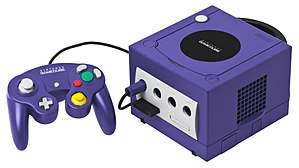Qoob chip
Qoob Chip is a modchip for the Nintendo GameCube, which allows the user to run unlicensed software such as BIOS replacements like GCOS, emulators, backup tools, and even operating systems such as Linux. The chip comes in two versions: SX and Pro.
| Manufacturer | Qoobchip |
|---|---|
| Type | Modchip |
| Generation | 3 (Flashable Modchip) |
| Lifespan | March 21, 2005 |
| Media | DVD-R, DVD+R and MiniDVD |
History
The chip was first considered a rumor or April Fools' Day joke, since it was said it supported direct booting of media instead of having to swap with an original disc, which none of the other modchips available at the time could. Qoob Chip however was released with all its said features on April 12, 2005 twenty two days after the first announcement of the product.[1]
Versions
There are two versions of the chip: Qoob Pro (which was the first to be released) and Qoob SX. Both versions share the same core, the pro version however have features which the SX does not: bigger flash memory and a USB connector for easy updating.
Pro version
The pro version of the Qoob chip is intended for developers and/or advanced users. The biggest differences from the SX version is the USB upgrade feature and 16Mbit flash memory.

List of features:
- Direct booting of all media.
- Support for all regions (PAL, USA and Japan).
- Upgrades via USB, DVD or network (network upgrade requires a Nintendo GameCube Broadband Adapter).
- 16Mbit on-board flash memory for application storage.
- BIOS selection/control.
- Support for all retail hardware, including Panasonic Q.
- Fastboot of original GameCube discs.
- Integrated media compatibility check.
- IPL replacement compatibility via SD card or network.
- Streaming Audio Fix.
- MP3 player software included. (removed in later BIOS revisions)
- Status LED
- Support for DVD-R, DVD+R and MiniDVD
- Support for multiple games per disc
- Support for multi-disc games.
- Support for Datel Action Replay.
SX version
Released after the pro version, the SX version is a stripped down version of the Qoob Pro chip, missing the USB upgrade feature and containing only 1Mbit of flash memory. The SX is equipped with a backup read-only BIOS preventing users or malicious code from "breaking" the chip.

List of features:
- Direct booting of all media.
- Support for all regions (PAL, USA and Japan).
- Upgrades via DVD and network (requires a broadband adapter).
- BIOS selection/control.
- Support for all retail hardware, including Panasonic Q.
- Fastboot of original GameCube discs.
- IPL replacement compatibility via SD card or network.
- Streaming Audio Fix.
- Integrated media compatibility check.
- Support for DVD-R, DVD+R, and MiniDVD
- Support for multiple games per disc
- Support for multi-disc games.
Hardware and installation
Both versions use the Actel FPGA, a flash memory (size depends on version) and a cable connector for the cables which are to be soldered onto the Gamecube mainboard. The Pro version also includes a flex cable connector, a highspeed USB controller, a USB connector board and an integrated status LED. Since there is a connector for the cables integrated to the chip there is no need to solder the cables onto the chip, eliminating accidental burning of the chip. There are six wires which are to be soldered onto the Gamecube mainboard, making the Qoob chip installation difficult for some users.
BIOS
The Qoob chip contain a BIOS which is upgradeable through different methods depending on the chip version. The official BIOS (Version 1.0 Release Candidate 4) is available through Qoob's official website, this version does not support unofficial versions of licensed products. The two chip versions have different BIOS versions, they however follow the same version number. After the release of Qoob BIOS 1.3c on 31 August 2005, the Qoob developers have since not released a new BIOS.
Versions
- Qoob BIOS 1.0 RC 4.
- This is the only BIOS officially available from the Qoob website, it doesn't support booting of backups.
- Qoob BIOS 1.1
- disc swap feature for games.
- network support.
- audio fix can be disabled.
- Qoob BIOS 1.2
- Panasonic Q support
- Multigame support
- minor bugfixes (workaround to some homebrew lib, iso9660 fix)
- Qoob BIOS 1.3
- Cheats (ActionReplay required once).
- Cheats: Current Game fuzzy autodetection.
- Configuration can be done in Menu.
- Settings can be stored in flash.
- DRE fix / swap support can be disabled.
- Time fixed.
- Background can be changed, texts can be disabled.
- In Game Reset (IGR).
- Video mode force (for games).
- Video mode configurable (for menu).
- Progressive support (even for PAL).
- Flash tool doesn't store full path anymore.
- Qoob BIOS 1.3a
- Bug fix.
- Qoob BIOS 1.3b3
- Transparent text backgrounds.
- Ability to flash several backgrounds at once.
- New warning has been implemented which shows when the readability due to laser or medium drops beneath a certain limit.
- Qoob BIOS 1.3c Final
- Background pictures can have non-black background.
- Selection of background picture.
- Some experiments in order to improve media stability.
Game backups
The Qoob chip with the official BIOS does not support booting unofficial versions of licensed software; however, there are modified versions of the BIOS available which allow direct booting of such copies. While denouncing copyright infringement of software, the designers of Qoob did not take steps to disable this behaviour.
References
- "Qoob Modchip". Qoob. Archived from the original on 2019-01-21. Retrieved 2006-07-08.
External links
- Qoob Chip Official website (domain has been cybersquatted)
- Gamefreax.de
- Official English Qoob Forums
- Dextrose
